1997 HONDA ODYSSEY manual transmission
[x] Cancel search: manual transmissionPage 199 of 241
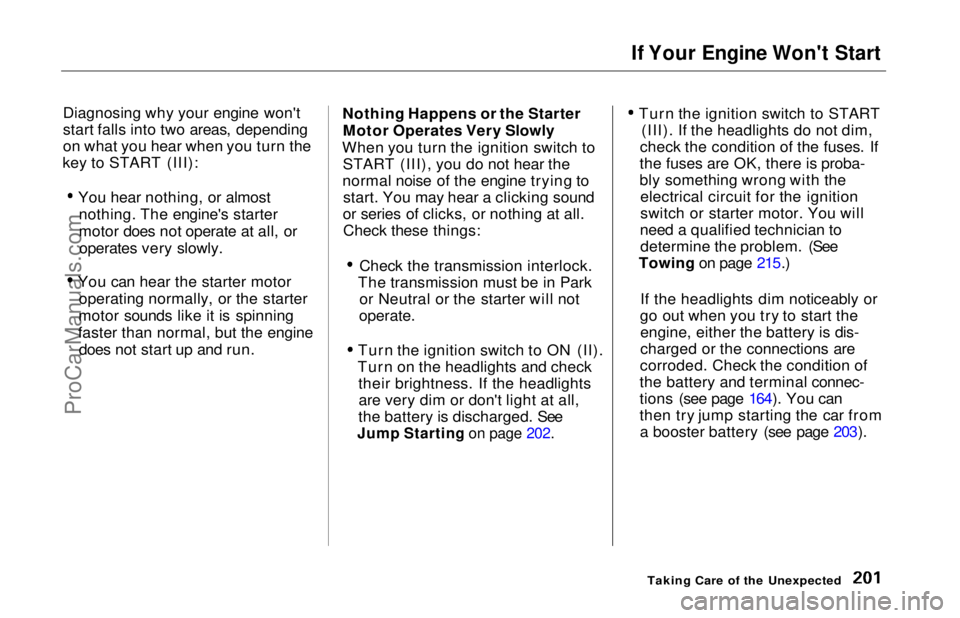
If Your Engine Won't Start
Diagnosing why your engine won't
start falls into two areas, depending
on what you hear when you turn the
key to START (III):
You hear nothing, or almostnothing. The engine's starter
motor does not operate at all, oroperates very slowly.
You can hear the starter motor operating normally, or the starter
motor sounds like it is spinning
faster than normal, but the engine does not start up and run. Nothing Happens or the Starter
Motor Operates Very Slowly
When you turn the ignition switch to START (III), you do not hear the
normal noise of the engine trying to start. You may hear a clicking sound
or series of clicks, or nothing at all. Check these things:
Check the transmission interlock.
The transmission must be in Park or Neutral or the starter will not
operate.
Turn the ignition switch to ON (II).
Turn on the headlights and check their brightness. If the headlightsare very dim or don't light at all,
the battery is discharged. See
Jump Starting on page 202.
Turn the ignition switch to START
(III). If the headlights do not dim,
check the condition of the fuses. If
the fuses are OK, there is proba-
bly something wrong with the electrical circuit for the ignition
switch or starter motor. You will
need a qualified technician to determine the problem. (See
Towing on page 215.)
If the headlights dim noticeably or
go out when you try to start the engine, either the battery is dis-
charged or the connections are
corroded. Check the condition of
the battery and terminal connec-
tions (see page 164). You can
then try jump starting the car from a booster battery (see page 203).
Taking Care of the UnexpectedProCarManuals.comMain Menu Table of Contents s t
Page 200 of 241
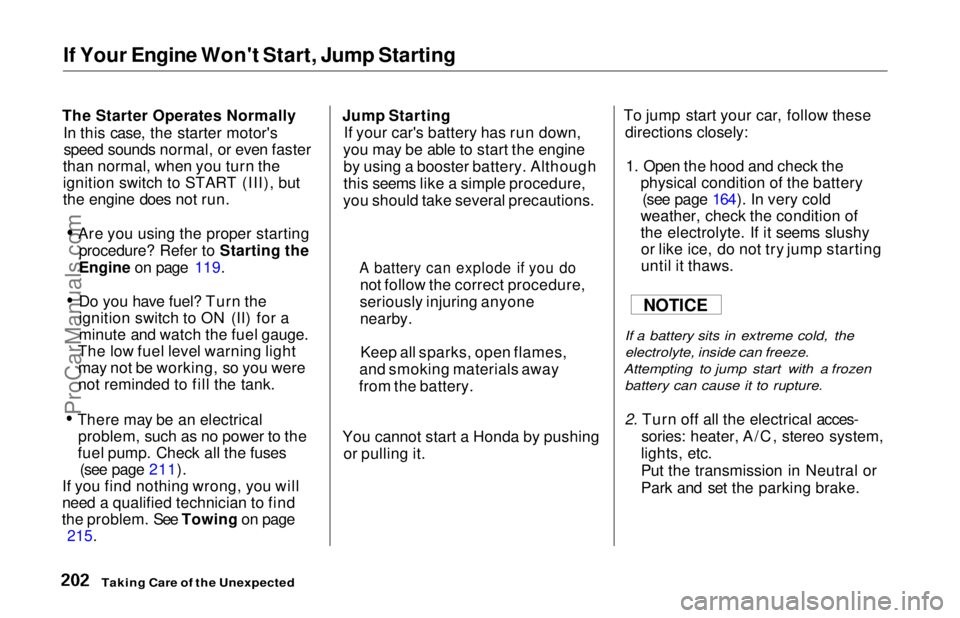
If Your Engine Won't Start, Jump Starting
The Starter Operates Normally In this case, the starter motor'sspeed sounds normal, or even faster
than normal, when you turn the
ignition switch to START (III), but
the engine does not run.
Are you using the proper startingprocedure? Refer to Starting the
Engine on page 119.
Do you have fuel? Turn the
ignition switch to ON (II) for a
minute and watch the fuel gauge.
The low fuel level warning light may not be working, so you were
not reminded to fill the tank.
There may be an electrical problem, such as no power to the
fuel pump. Check all the fuses (see page 211).
If you find nothing wrong, you will
need a qualified technician to find
the problem. See Towing on page
215.
Jump Starting
If your car's battery has run down,
you may be able to start the engine by using a booster battery. Although
this seems like a simple procedure,
you should take several precautions.
You cannot start a Honda by pushing or pulling it. To jump start your car, follow these
directions closely:
1. Open the hood and check the physical condition of the battery(see page 164). In very cold
weather, check the condition of
the electrolyte. If it seems slushy or like ice, do not try jump starting
until it thaws.
If a battery sits in extreme cold, the electrolyte, inside can freeze.
Attempting to jump start with a frozen battery can cause it to rupture.
2. Turn off all the electrical acces-
sories: heater, A/C, stereo system,
lights, etc.
Put the transmission in Neutral or
Park and set the parking brake.
Taking Care of the Unexpected
A battery can explode if you do
not follow the correct procedure,
seriously injuring anyone nearby.
Keep all sparks, open flames,
and smoking materials away
from the battery.
NOTICEProCarManuals.comMain Menu Table of Contents s t
Page 202 of 241

If Your Engine Overheats
The pointer of your car's tempera- ture gauge should stay in the mid-range under most conditions. It may
go higher if you are driving up a long steep hill on a very hot day. If it
climbs to the red mark, you should
determine the reason.
Driving with the temperature gauge
pointer at the red mark can cause serious damage to your engine. Your car can overheat for several
reasons, such as lack of coolant or a
mechanical problem. The only
indication may be the temperature
gauge climbing to or above the red mark. Or you may see steam or
spray coming from under the hood.
In either case, you should take
immediate action.
1. Safely pull to the side of the road.
Put the transmission in Neutral or
Park and set the parking brake.
Turn off the heating and cooling system and all other accessories.
Turn on the hazard warning indicators.
2. If you see steam and/or spray coming from under the hood, turnoff the engine.
3. If you do not see steam or spray, leave the engine running and
watch the temperature gauge. If the high heat is due to overloading (climbing a long, steep hill on a
hot day with the A/C running, for example), the engine should start
to cool down almost immediately. If it does, wait until the tempera-
ture gauge comes down to the mid-
point then continue driving.
Taking Care of the Unexpected
NOTICE
Steam and spray from an
overheated engine can
seriously scald you.
Do not open the hood if steam
is coming out.ProCarManuals.comMain Menu Table of Contents s t
Page 213 of 241
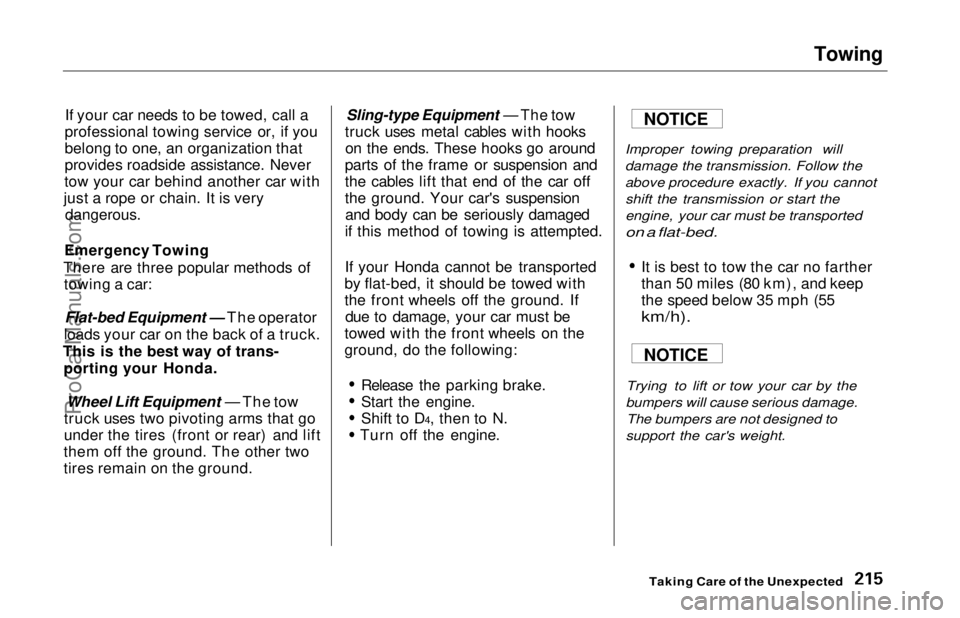
Towing
If your car needs to be towed, call a
professional towing service or, if you
belong to one, an organization that
provides roadside assistance. Never
tow your car behind another car with
just a rope or chain. It is very
dangerous.
Emergency Towing
There are three popular methods of towing a car:
Flat-bed Equipment — The operator
loads your car on the back of a truck.
This is the best way of trans- porting your Honda.
Wheel Lift Equipment — The tow
truck uses two pivoting arms that go
under the tires (front or rear) and lift
them off the ground. The other two
tires remain on the ground.
Sling-type Equipment — The tow
truck uses metal cables with hooks on the ends. These hooks go around
parts of the frame or suspension and
the cables lift that end of the car off
the ground. Your car's suspension and body can be seriously damaged
if this method of towing is attempted.
If your Honda cannot be transported
by flat-bed, it should be towed with
the front wheels off the ground. If due to damage, your car must be
towed with the front wheels on the
ground, do the following:
Release the parking brake.
Start the engine.
Shift to D4, then to N.
Turn off the engine.
Improper towing preparation will
damage the transmission. Follow the
above procedure exactly. If you cannot
shift the transmission or start the
engine, your car must be transported
on a flat-bed.
It is best to tow the car no farther
than 50 miles (80 km), and keep
the speed below 35 mph (55
km/h).
Trying to lift or tow your car by the
bumpers will cause serious damage. The bumpers are not designed to
support the car's weight.
Taking Care of the Unexpected
NOTICE
NOTICEProCarManuals.comMain Menu Table of Contents s t
Page 216 of 241
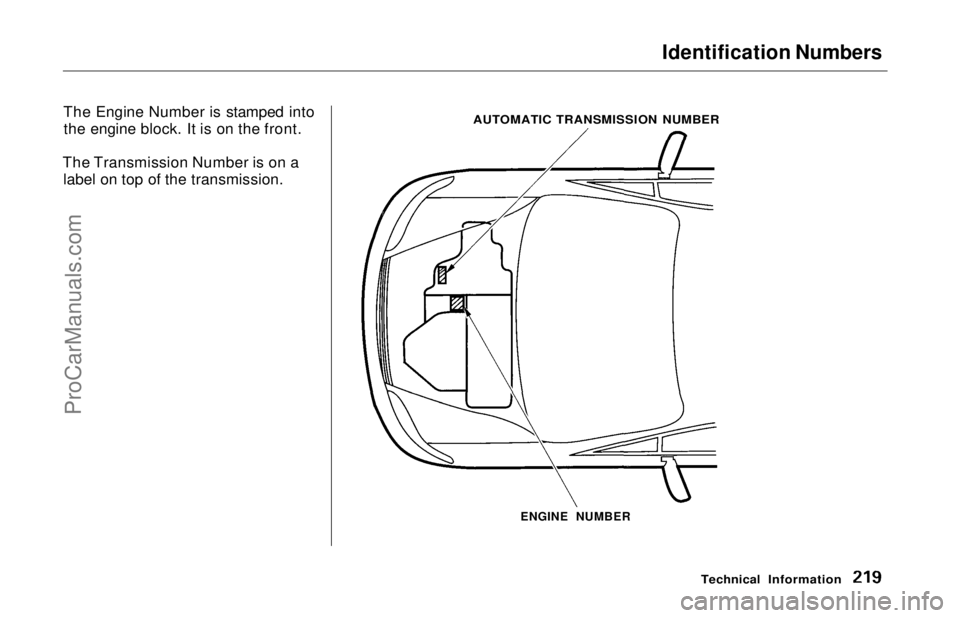
Identification Numbers
The Engine Number is stamped into the engine block. It is on the front.
The Transmission Number is on a label on top of the transmission.
Technical Information
AUTOMATIC TRANSMISSION NUMBER
ENGINE NUMBERProCarManuals.comMain Menu Table of Contents s t
Page 233 of 241
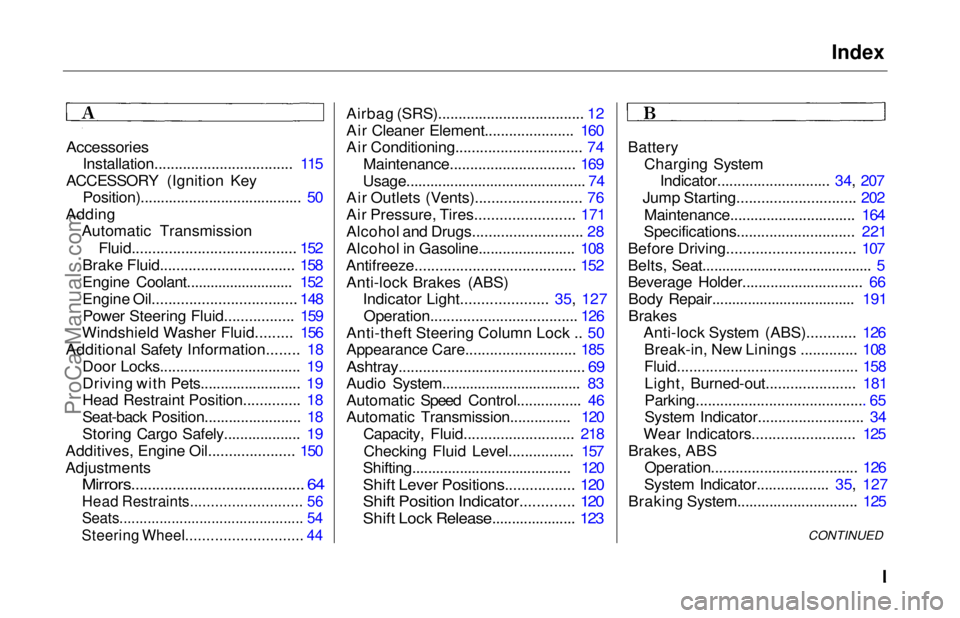
Index
Accessories
Installation.................................. 115
ACCESSORY (Ignition Key Position)........................................ 50
Adding Automatic Transmission
Fluid........................................ 152
Brake Fluid................................. 158
Engine Coolant........................... 152
Engine Oil................................... 148 Power Steering Fluid................. 159
Windshield Washer Fluid......... 156
Additional Safety Information........ 18 Door Locks................................... 19
Driving with Pets......................... 19
Head Restraint Position.............. 18
Seat-back Position........................ 18
Storing Cargo Safely................... 19
Additives, Engine Oil..................... 150
Adjustments
Mirrors.......................................... 64
Head Restraints........................... 56
Seats.............................................. 54
Steering Wheel............................ 44
Airbag (SRS).................................... 12
Air Cleaner Element...................... 160
Air Conditioning............................... 74
Maintenance............................... 169
Usage............................................. 74
Air Outlets (Vents).......................... 76
Air Pressure, Tires........................ 171
Alcohol and Drugs........................... 28
Alcohol in Gasoline........................ 108
Antifreeze....................................... 152 Anti-lock Brakes (ABS) Indicator Light..................... 35, 127
Operation.................................... 126
Anti-theft Steering Column Lock .. 50
Appearance Care........................... 185
Ashtray.............................................. 69
Audio System................................... 83
Automatic Speed Control................ 46
Automatic Transmission............... 120 Capacity, Fluid........................... 218
Checking Fluid Level................ 157
Shifting........................................ 120
Shift Lever Positions................. 120
Shift Position Indicator............. 120
Shift Lock Release..................... 123
Battery
Charging SystemIndicator............................ 34, 207
Jump Starting............................. 202
Maintenance............................... 164
Specifications............................. 221
Before Driving............................... 107
Belts, Seat........................................... 5
Beverage Holder.............................. 66 Body Repair.................................... 191
Brakes
Anti-lock System (ABS)............ 126
Break-in, New Linings .............. 108
Fluid............................................ 158
Light, Burned-out...................... 181
Parking.......................................... 65
System Indicator.......................... 34
Wear Indicators......................... 125
Brakes, ABS Operation.................................... 126
System Indicator.................. 35, 127
Braking System.............................. 125
CONTINUEDProCarManuals.comMain Menu s t
Page 234 of 241
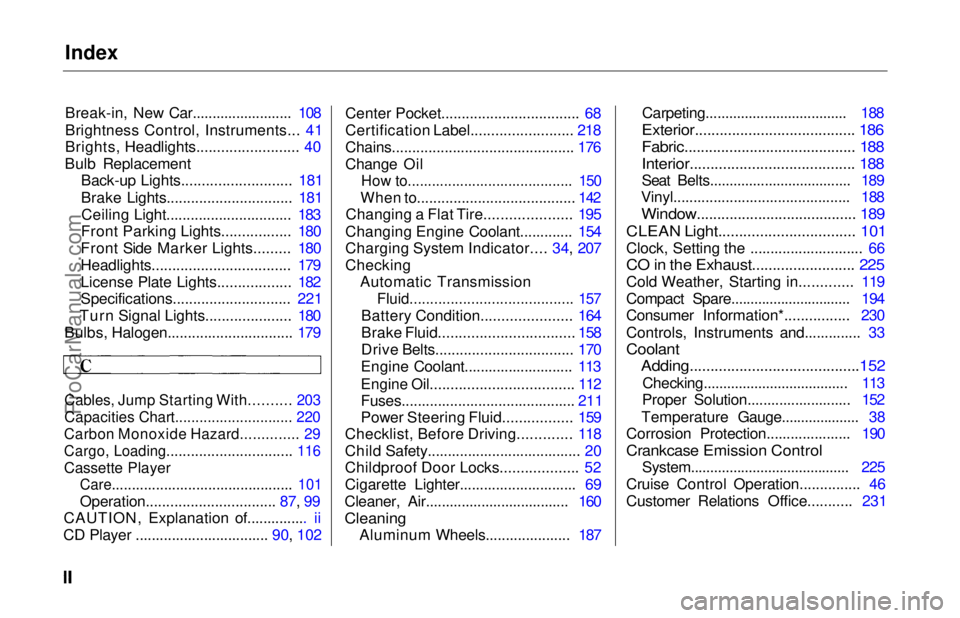
Index
Break-in, New Car......................... 108
Brightness Control, Instruments... 41
Brights, Headlights......................... 40
Bulb Replacement Back-up Lights........................... 181
Brake Lights............................... 181
Ceiling Light............................... 183
Front Parking Lights................. 180
Front Side Marker Lights......... 180
Headlights.................................. 179
License Plate Lights.................. 182
Specifications............................. 221
Turn Signal Lights..................... 180
Bulbs, Halogen............................... 179
Cables, Jump Starting With.......... 203
Capacities Chart............................. 220
Carbon Monoxide Hazard.............. 29
Cargo, Loading............................... 116
Cassette Player
Care............................................. 101
Operation................................ 87, 99
CAUTION, Explanation of............... ii
CD Player ................................. 90, 102 Center Pocket.................................. 68
Certification Label......................... 218
Chains............................................. 176
Change Oil
How to......................................... 150
When to....................................... 142
Changing a Flat Tire..................... 195
Changing Engine Coolant............. 154
Charging System Indicator.... 34, 207
Checking Automatic Transmission
Fluid........................................ 157
Battery Condition...................... 164
Brake Fluid................................. 158
Drive Belts.................................. 170
Engine Coolant........................... 113
Engine Oil................................... 112
Fuses........................................... 211
Power Steering Fluid................. 159
Checklist, Before Driving............. 118
Child Safety...................................... 20
Childproof Door Locks................... 52
Cigarette Lighter............................. 69
Cleaner, Air.................................... 160
Cleaning
Aluminum Wheels..................... 187 Carpeting.................................... 188
Exterior....................................... 186
Fabric.......................................... 188
Interior........................................ 188
Seat Belts.................................... 189
Vinyl............................................ 188
Window....................................... 189
CLEAN Light................................. 101
Clock, Setting the ............................ 66
CO in the Exhaust......................... 225
Cold Weather, Starting in............. 119
Compact Spare............................... 194
Consumer Information*................ 230
Controls, Instruments and.............. 33
Coolant
Adding.........................................152
Checking..................................... 113
Proper Solution.......................... 152
Temperature Gauge.................... 38
Corrosion Protection..................... 190
Crankcase Emission Control
System......................................... 225
Cruise Control Operation............... 46
Customer Relations Office........... 231ProCarManuals.comMain Menu s t
Page 235 of 241
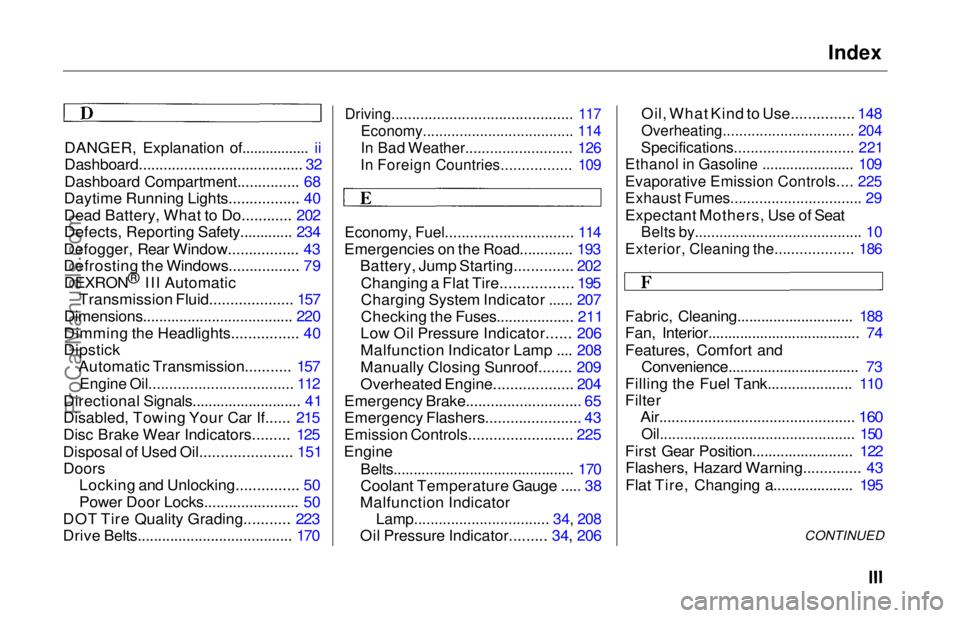
Index
DANGER, Explanation of................. ii
Dashboard........................................ 32
Dashboard Compartment............... 68
Daytime Running Lights................. 40
Dead Battery, What to Do............ 202
Defects, Reporting Safety............. 234
Defogger, Rear Window................. 43
Defrosting the Windows................. 79 DEXRON ®
III Automatic
Transmission Fluid.................... 157
Dimensions..................................... 220
Dimming the Headlights................ 40
Dipstick Automatic Transmission........... 157
Engine Oil................................... 112
Directional Signals........................... 41
Disabled, Towing Your Car If...... 215
Disc Brake Wear Indicators......... 125
Disposal of Used Oil...................... 151 Doors Locking and Unlocking............... 50
Power Door Locks....................... 50
DOT Tire Quality Grading........... 223
Drive Belts...................................... 170
Driving............................................ 117
Economy..................................... 114
In Bad Weather.......................... 126
In Foreign Countries................. 109
Economy, Fuel............................... 114
Emergencies on the Road............. 193
Battery, Jump Starting.............. 202
Changing a Flat Tire................. 195
Charging System Indicator ...... 207
Checking the Fuses................... 211
Low Oil Pressure Indicator...... 206
Malfunction Indicator Lamp .... 208
Manually Closing Sunroof........ 209
Overheated Engine................... 204
Emergency Brake............................ 65
Emergency Flashers....................... 43
Emission Controls......................... 225
Engine
Belts............................................. 170
Coolant Temperature Gauge ..... 38
Malfunction Indicator
Lamp................................. 34, 208
Oil Pressure Indicator......... 34, 206 Oil, What Kind to Use............... 148
Overheating................................ 204
Specifications............................. 221
Ethanol in Gasoline ....................... 109
Evaporative Emission Controls.... 225
Exhaust Fumes................................ 29
Expectant Mothers, Use of Seat
Belts by......................................... 10
Exterior, Cleaning the................... 186
Fabric, Cleaning............................. 188
Fan, Interior...................................... 74
Features, Comfort and Convenience................................. 73
Filling the Fuel Tank..................... 110
Filter
Air................................................ 160
Oil................................................ 150
First Gear Position......................... 122 Flashers, Hazard Warning.............. 43
Flat Tire, Changing a.................... 195
CONTINUEDProCarManuals.comMain Menu s t